Justin T. Chiu
Command A: An Enterprise-Ready Large Language Model
Apr 01, 2025Abstract:In this report we describe the development of Command A, a powerful large language model purpose-built to excel at real-world enterprise use cases. Command A is an agent-optimised and multilingual-capable model, with support for 23 languages of global business, and a novel hybrid architecture balancing efficiency with top of the range performance. It offers best-in-class Retrieval Augmented Generation (RAG) capabilities with grounding and tool use to automate sophisticated business processes. These abilities are achieved through a decentralised training approach, including self-refinement algorithms and model merging techniques. We also include results for Command R7B which shares capability and architectural similarities to Command A. Weights for both models have been released for research purposes. This technical report details our original training pipeline and presents an extensive evaluation of our models across a suite of enterprise-relevant tasks and public benchmarks, demonstrating excellent performance and efficiency.
A Controlled Study on Long Context Extension and Generalization in LLMs
Sep 18, 2024



Abstract:Broad textual understanding and in-context learning require language models that utilize full document contexts. Due to the implementation challenges associated with directly training long-context models, many methods have been proposed for extending models to handle long contexts. However, owing to differences in data and model classes, it has been challenging to compare these approaches, leading to uncertainty as to how to evaluate long-context performance and whether it differs from standard evaluation. We implement a controlled protocol for extension methods with a standardized evaluation, utilizing consistent base models and extension data. Our study yields several insights into long-context behavior. First, we reaffirm the critical role of perplexity as a general-purpose performance indicator even in longer-context tasks. Second, we find that current approximate attention methods systematically underperform across long-context tasks. Finally, we confirm that exact fine-tuning based methods are generally effective within the range of their extension, whereas extrapolation remains challenging. All codebases, models, and checkpoints will be made available open-source, promoting transparency and facilitating further research in this critical area of AI development.
Language Model Inversion
Nov 22, 2023Abstract:Language models produce a distribution over the next token; can we use this information to recover the prompt tokens? We consider the problem of language model inversion and show that next-token probabilities contain a surprising amount of information about the preceding text. Often we can recover the text in cases where it is hidden from the user, motivating a method for recovering unknown prompts given only the model's current distribution output. We consider a variety of model access scenarios, and show how even without predictions for every token in the vocabulary we can recover the probability vector through search. On Llama-2 7b, our inversion method reconstructs prompts with a BLEU of $59$ and token-level F1 of $78$ and recovers $27\%$ of prompts exactly. Code for reproducing all experiments is available at http://github.com/jxmorris12/vec2text.
Asking More Informative Questions for Grounded Retrieval
Nov 14, 2023



Abstract:When a model is trying to gather information in an interactive setting, it benefits from asking informative questions. However, in the case of a grounded multi-turn image identification task, previous studies have been constrained to polar yes/no questions, limiting how much information the model can gain in a single turn. We present an approach that formulates more informative, open-ended questions. In doing so, we discover that off-the-shelf visual question answering (VQA) models often make presupposition errors, which standard information gain question selection methods fail to account for. To address this issue, we propose a method that can incorporate presupposition handling into both question selection and belief updates. Specifically, we use a two-stage process, where the model first filters out images which are irrelevant to a given question, then updates its beliefs about which image the user intends. Through self-play and human evaluations, we show that our method is successful in asking informative open-ended questions, increasing accuracy over the past state-of-the-art by 14%, while resulting in 48% more efficient games in human evaluations.
Symbolic Planning and Code Generation for Grounded Dialogue
Oct 26, 2023



Abstract:Large language models (LLMs) excel at processing and generating both text and code. However, LLMs have had limited applicability in grounded task-oriented dialogue as they are difficult to steer toward task objectives and fail to handle novel grounding. We present a modular and interpretable grounded dialogue system that addresses these shortcomings by composing LLMs with a symbolic planner and grounded code execution. Our system consists of a reader and planner: the reader leverages an LLM to convert partner utterances into executable code, calling functions that perform grounding. The translated code's output is stored to track dialogue state, while a symbolic planner determines the next appropriate response. We evaluate our system's performance on the demanding OneCommon dialogue task, involving collaborative reference resolution on abstract images of scattered dots. Our system substantially outperforms the previous state-of-the-art, including improving task success in human evaluations from 56% to 69% in the most challenging setting.
Abductive Commonsense Reasoning Exploiting Mutually Exclusive Explanations
May 24, 2023



Abstract:Abductive reasoning aims to find plausible explanations for an event. This style of reasoning is critical for commonsense tasks where there are often multiple plausible explanations. Existing approaches for abductive reasoning in natural language processing (NLP) often rely on manually generated annotations for supervision; however, such annotations can be subjective and biased. Instead of using direct supervision, this work proposes an approach for abductive commonsense reasoning that exploits the fact that only a subset of explanations is correct for a given context. The method uses posterior regularization to enforce a mutual exclusion constraint, encouraging the model to learn the distinction between fluent explanations and plausible ones. We evaluate our approach on a diverse set of abductive reasoning datasets; experimental results show that our approach outperforms or is comparable to directly applying pretrained language models in a zero-shot manner and other knowledge-augmented zero-shot methods.
HOP, UNION, GENERATE: Explainable Multi-hop Reasoning without Rationale Supervision
May 23, 2023



Abstract:Explainable multi-hop question answering (QA) not only predicts answers but also identifies rationales, i. e. subsets of input sentences used to derive the answers. This problem has been extensively studied under the supervised setting, where both answer and rationale annotations are given. Because rationale annotations are expensive to collect and not always available, recent efforts have been devoted to developing methods that do not rely on supervision for rationales. However, such methods have limited capacities in modeling interactions between sentences, let alone reasoning across multiple documents. This work proposes a principled, probabilistic approach for training explainable multi-hop QA systems without rationale supervision. Our approach performs multi-hop reasoning by explicitly modeling rationales as sets, enabling the model to capture interactions between documents and sentences within a document. Experimental results show that our approach is more accurate at selecting rationales than the previous methods, while maintaining similar accuracy in predicting answers.
Teal: Learning-Accelerated Optimization of Traffic Engineering
Oct 25, 2022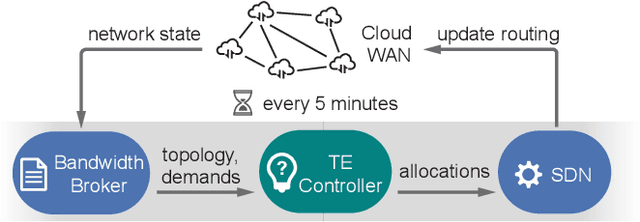
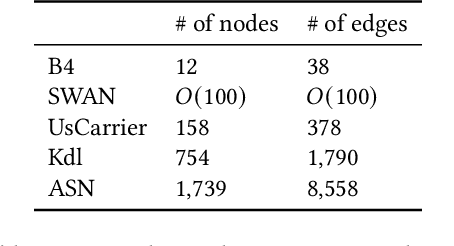
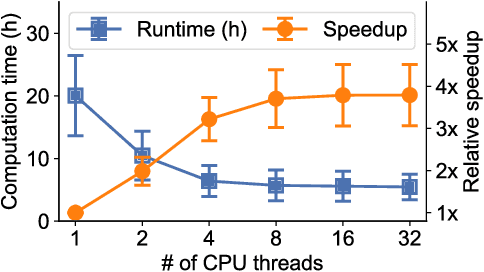
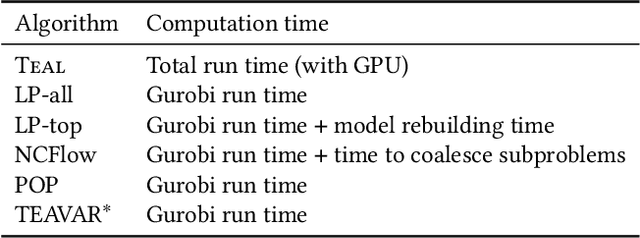
Abstract:In the last decade, global cloud wide-area networks (WANs) have grown 10$\times$ in size due to the deployment of new network sites and datacenters, making it challenging for commercial optimization engines to solve the network traffic engineering (TE) problem within the temporal budget of a few minutes. In this work, we show that carefully designed deep learning models are key to accelerating the running time of intra-WAN TE systems for large deployments since deep learning is both massively parallel and it benefits from the wealth of historical traffic allocation data from production WANs. However, off-the-shelf deep learning methods fail to perform well on the TE task since they ignore the effects of network connectivity on flow allocations. They are also faced with a tractability challenge posed by the large problem scale of TE optimization. Moreover, neural networks do not have mechanisms to readily enforce hard constraints on model outputs (e.g., link capacity constraints). We tackle these challenges by designing a deep learning-based TE system -- Teal. First, Teal leverages graph neural networks (GNN) to faithfully capture connectivity and model network flows. Second, Teal devises a multi-agent reinforcement learning (RL) algorithm to process individual demands independently in parallel to lower the problem scale. Finally, Teal reduces link capacity violations and improves solution quality using the alternating direction method of multipliers (ADMM). We evaluate Teal on traffic matrices of a global commercial cloud provider and find that Teal computes near-optimal traffic allocations with a 59$\times$ speedup over state-of-the-art TE systems on a WAN topology of over 1,500 nodes.
Low-Rank Constraints for Fast Inference in Structured Models
Jan 08, 2022



Abstract:Structured distributions, i.e. distributions over combinatorial spaces, are commonly used to learn latent probabilistic representations from observed data. However, scaling these models is bottlenecked by the high computational and memory complexity with respect to the size of the latent representations. Common models such as Hidden Markov Models (HMMs) and Probabilistic Context-Free Grammars (PCFGs) require time and space quadratic and cubic in the number of hidden states respectively. This work demonstrates a simple approach to reduce the computational and memory complexity of a large class of structured models. We show that by viewing the central inference step as a matrix-vector product and using a low-rank constraint, we can trade off model expressivity and speed via the rank. Experiments with neural parameterized structured models for language modeling, polyphonic music modeling, unsupervised grammar induction, and video modeling show that our approach matches the accuracy of standard models at large state spaces while providing practical speedups.
Reference-Centric Models for Grounded Collaborative Dialogue
Sep 10, 2021
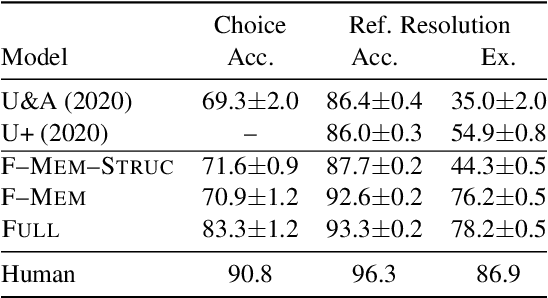
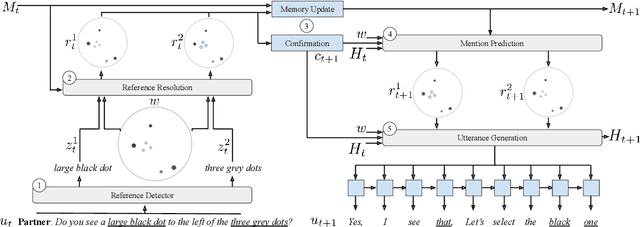

Abstract:We present a grounded neural dialogue model that successfully collaborates with people in a partially-observable reference game. We focus on a setting where two agents each observe an overlapping part of a world context and need to identify and agree on some object they share. Therefore, the agents should pool their information and communicate pragmatically to solve the task. Our dialogue agent accurately grounds referents from the partner's utterances using a structured reference resolver, conditions on these referents using a recurrent memory, and uses a pragmatic generation procedure to ensure the partner can resolve the references the agent produces. We evaluate on the OneCommon spatial grounding dialogue task (Udagawa and Aizawa 2019), involving a number of dots arranged on a board with continuously varying positions, sizes, and shades. Our agent substantially outperforms the previous state of the art for the task, obtaining a 20% relative improvement in successful task completion in self-play evaluations and a 50% relative improvement in success in human evaluations.
 Add to Chrome
Add to Chrome Add to Firefox
Add to Firefox Add to Edge
Add to Edge